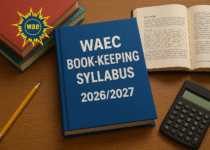WAEC Basketry Syllabus 2026/2027 & Textbooks
The WAEC Basketry Syllabus 2026/2027 & Textbooks: covers both theoretical and practical aspects of the craft, including the history, socio-cultural significance, and entrepreneurship related to basket making. Key areas include the elements and principles of design, a wide range of techniques like coiling, plaiting, and weaving, preparation and care of materials, and the finishing of articles like baskets, hats, and mats. The exam consists of theory papers and a practical project.
Contents
Aims & Objective
- Candidates Must understand knowledge and understanding of the historical developments and socio-economic importance of basketry
- Candidates must understand the creative skills and manipulative skills in designing and production of various forms of basketry based on societal and cultural needs
- Candidates must understand the creative and manipulative skills in designing and production of various forms of basketry by employing the traditions and cultures of the society
- Candidates must have kknowledge of how to plan and establish a sustainable small-scale industry
- Candidates must have knowledge of appreciation and evaluation of basketry
WAEC Examination Guidelines 2026/2027
There will be three papers, Papers 1, 2, and 3, all of which must be taken. Papers 1 and 2 will be a composite paper to be taken at one sitting.
PAPER 1: Will consist of forty multiple choice objective questions, all of which must be answered within 50 minutes for 40 marks.
PAPER 2: Will consist of six essay-type questions. Candidates will be required to answer four questions within 2 hours for 60 marks.
PAPER 3: Will be two practical projects, out of which candidates will execute one within five days, working for six hours each of the days. The paper will carry 80 marks.
The question papers will be sent to the candidates two weeks before the execution period for candidates to study. Designing sketches and preparatory notes should also be done within two weeks prior to the execution of the project. These will carry 20 marks. The total mark for the paper is, therefore, 100.
The course in Basketry includes a study of the historical development and socio-cultural and economic significance of basketry as an art and vocation. Basketry also covers the preparation, care and use of materials and various techniques for designing and making of articles of functional and aesthetic values to satisfy identified needs. Candidates also are expected to have acquired and applied knowledge and skills in entrepreneurship.
WAEC Basketry Syllabus 2026/2027
| Main Topic | Subtopics / Content Details |
|---|---|
| MEANING AND SCOPE OF BASKETRY | – Meaning: Basketry is the craft of making items by weaving or interlacing flexible materials. – Scope/Areas Covered: Coiled work, woven articles, frameworks, macramé, etc. – Articles Made: Baskets, hats, mats, nets, couches, footwear, cots, etc. – Techniques Used: Weaving, plaiting, coiling, stitching, knotting, and construction. – Combination of Materials: Use of cowries, gourds, beads, and similar materials to create rattles, macramé, etc. |
| RATIONALE FOR STUDYING BASKETRY | – Encourages creative use of new and local materials for articles of cultural, functional, and aesthetic value. – Promotes skills acquisition for employment and further studies. – Supports tourism and cultural heritage promotion. |
| HISTORY, SOCIAL, CULTURAL AND ECONOMIC IMPORTANCE | – History: Origin and evolution of basketry. – Social Importance: Basketry as a medium of social expression and entertainment. – Cultural Importance: Role in festivals, traditions, and identity. – Economic Importance: Contributions to agriculture, trade, and commerce. |
| PLACES, PEOPLE AND BASKETRY | – Contributions of notable people and localities to the development of basketry traditions and techniques. |
| COMPETENCIES AND ATTITUDES | – Development of knowledge, creative thinking, skills, and values for employment (e.g. weaving, designing). – Promotion of tolerance, diligence, honesty, and commitment. – Enhancement of communication skills and time management. |
| PREPARATION OF MATERIALS | – Skills and Techniques: Drying, wetting, softening, and treating materials. – Storage and Care: Chemical and non-chemical preservation. – Sustainability: Conservation of raw material sources (ecology, preventing bush burning). – Understanding Material Characteristics: Discovering material qualities and appropriate uses. |
| TOOLS AND THEIR USES | – Categories: Cutting, weaving, shaping, measuring, and finishing tools. – Description and Uses: Drawing and labeling of tools. – Improvisation: Creating alternative tools using available resources. – Care and Maintenance: Cleaning, sharpening, and proper storage. – Safety Precautions: Safe handling and use of tools. |
| ELEMENTS OF DESIGN | – Identification: Recognizing design elements such as dot, line, shape, form, color, and texture. – Creation: Using weaving, knotting, coiling, and waling to express design elements. – Color Theory: 12-point color wheel, Ghanaian color concept, and symbolism. |
| PRINCIPLES OF DESIGN | – Identification: Unity, balance, proportion, repetition, contrast, and rhythm in design. – Application: Using spraying, scorching, weaving, and other techniques to demonstrate principles of design. |
| BASIC DESIGN AND TECHNOLOGY | – Definition of Design: The process of conceiving and planning functional or aesthetic objects. – Idea Creation: Drawing from memory, imagination, and observation. – Use of Tools and Materials: Applying proper techniques and resources. |
| DESIGNING ARTICLES TO SUIT SPECIFIC NEEDS | – Design Process: Creating by hand or computer. – Techniques: Weaving, knotting, plaiting, coiling, stitching, framing, etc. – Evaluation Criteria: Use of appropriate materials, color, technique, and finishing quality. |
| SUSTAINABLE DEVELOPMENT OF BASKETRY | – Strategies: Re-afforestation, waste management, eco-friendly material sourcing. – Challenges: Competition with plastic products, limited raw materials. – Solutions: Formation of cooperatives, innovation, and maintaining competitiveness. |
| DECORATION AND FINISHING | – Definition of Decoration: Enhancing the surface or appearance of an article. – Definition of Finishing: The final process that improves durability and appearance. – Decoration Techniques: Use of colored/uncolored weavers, weave variations, scorching, spraying, and adding complementary objects. – Finishing Techniques: Wrapping, binding, singeing, trimming, tying, lashing, bending, gluing, sanding, varnishing, lacquering, embroidering, sealing, and bordering. |
| ENTREPRENEURIAL SKILLS IN PRACTICE | – Portfolio Development: Prints, photos, videos (CDs/DVDs) of finished works. |
| BUSINESS PLAN | – Meaning: A detailed written plan outlining business goals and strategies. – Purpose: To guide operations and attract investors. – Steps in Organization: Registration, securing capital, choosing location, obtaining materials and tools, conducting market surveys. |
| THE BUSINESS | – Capital Sources: Bank loans, cooperatives, personal savings. – Exhibition: Types – general and specialized. |
| BUSINESS PROMOTION | – Methods: Billboards, internet, print media, TV, radio, handbills, posters. – Entrepreneurial Skills: Marketing, innovation, customer relations. |
| PACKAGING AND HANDLING | – Definition: Preparing finished products for storage, sale, or transportation. – Functions: Protect products and enhance presentation. – Disadvantages of Poor Packaging: Damage, low appeal, and customer dissatisfaction. – Types of Packaging: Primary, secondary, and tertiary packaging. |
| COSTING AND PRICING | – Definition: Determining the total production cost and setting selling prices. – Types of Cost: Variable cost (materials, labor) and fixed cost (rent, equipment). – Importance: Ensures profitability and business sustainability. |
Related Posts
- WAEC Animal Husbandry Syllabus 2026/2027 & Textbooks
- WAEC Yoruba Syllabus 2026/2027 & Textbooks
- WAEC Book-Keeping Syllabus 2026/2027 & Textbooks
- WAEC Marketing Syllabus 2026/2027 & Textbooks
- WAEC Chemistry Syllabus 2026/2027 & Texbooks
- WAEC Arabic Syllabus 2026/2027 & Textbooks
- WAEC Syllabus For Economics 2026/2027 & Textbooks
- WAEC Literature-in-English Syllabus 2026/2027 & Textbooks
- WAEC Igbo Syllabus 2026/2027 & Textbooks
- WAEC Islamic Religious Studies (IRS) Syllabus 2026/2027
- WAEC Government Syllabus 2026/2027 and Textbooks
- WAEC Arabic Syllabus 2026/2027 & Textbooks
- WAEC Music Syllabus 2026/2027 & Textbooks
- WAEC Food and Nutrition Syllabus 2026/2027 & Textbooks
- WAEC Data Processing Syllabus 2026/2027 & Textbooks
- WAEC Further Mathematics Syllabus 2026/2027 & Textbooks
- WAEC Financial Accounting Syllabus 2026/2027 & Textbooks
- WAEC Geography Syllabus 2026/2027 & Textbooks


